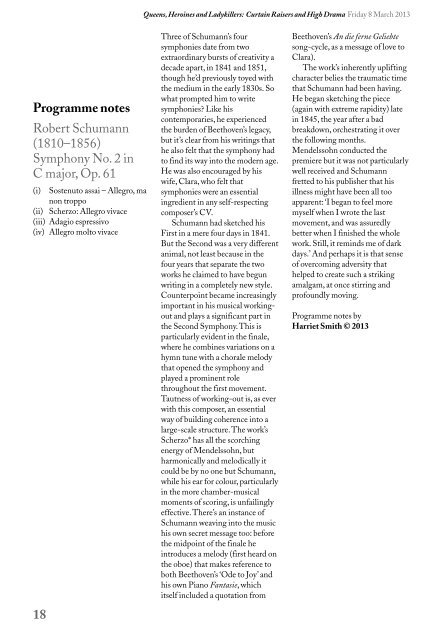download here. - Orchestra of the Age of Enlightenment
download here. - Orchestra of the Age of Enlightenment
download here. - Orchestra of the Age of Enlightenment
Create successful ePaper yourself
Turn your PDF publications into a flip-book with our unique Google optimized e-Paper software.
Queens, Heroines and Ladykillers: Curtain Raisers and High Drama Friday 8 March 2013<br />
Programme notes<br />
Robert Schumann<br />
(1810–1856)<br />
Symphony No. 2 in<br />
C major, Op. 61<br />
(i) Sostenuto assai – Allegro, ma<br />
non troppo<br />
(ii) Scherzo: Allegro vivace<br />
(iii) Adagio espressivo<br />
(iv) Allegro molto vivace<br />
18<br />
Three <strong>of</strong> Schumann’s four<br />
symphonies date from two<br />
extraordinary bursts <strong>of</strong> creativity a<br />
decade apart, in 1841 and 1851,<br />
though he’d previously toyed with<br />
<strong>the</strong> medium in <strong>the</strong> early 1830s. So<br />
what prompted him to write<br />
symphonies? Like his<br />
contemporaries, he experienced<br />
<strong>the</strong> burden <strong>of</strong> Beethoven’s legacy,<br />
but it’s clear from his writings that<br />
he also felt that <strong>the</strong> symphony had<br />
to find its way into <strong>the</strong> modern age.<br />
He was also encouraged by his<br />
wife, Clara, who felt that<br />
symphonies were an essential<br />
ingredient in any self-respecting<br />
composer’s CV.<br />
Schumann had sketched his<br />
First in a mere four days in 1841.<br />
But <strong>the</strong> Second was a very different<br />
animal, not least because in <strong>the</strong><br />
four years that separate <strong>the</strong> two<br />
works he claimed to have begun<br />
writing in a completely new style.<br />
Counterpoint became increasingly<br />
important in his musical workingout<br />
and plays a significant part in<br />
<strong>the</strong> Second Symphony. This is<br />
particularly evident in <strong>the</strong> finale,<br />
w<strong>here</strong> he combines variations on a<br />
hymn tune with a chorale melody<br />
that opened <strong>the</strong> symphony and<br />
played a prominent role<br />
throughout <strong>the</strong> first movement.<br />
Tautness <strong>of</strong> working-out is, as ever<br />
with this composer, an essential<br />
way <strong>of</strong> building co<strong>here</strong>nce into a<br />
large-scale structure. The work’s<br />
Scherzo* has all <strong>the</strong> scorching<br />
energy <strong>of</strong> Mendelssohn, but<br />
harmonically and melodically it<br />
could be by no one but Schumann,<br />
while his ear for colour, particularly<br />
in <strong>the</strong> more chamber-musical<br />
moments <strong>of</strong> scoring, is unfailingly<br />
effective. T<strong>here</strong>’s an instance <strong>of</strong><br />
Schumann weaving into <strong>the</strong> music<br />
his own secret message too: before<br />
<strong>the</strong> midpoint <strong>of</strong> <strong>the</strong> finale he<br />
introduces a melody (first heard on<br />
<strong>the</strong> oboe) that makes reference to<br />
both Beethoven’s ‘Ode to Joy’ and<br />
his own Piano Fantasie, which<br />
itself included a quotation from<br />
Beethoven’s An die ferne Geliebte<br />
song-cycle, as a message <strong>of</strong> love to<br />
Clara).<br />
The work’s in<strong>here</strong>ntly uplifting<br />
character belies <strong>the</strong> traumatic time<br />
that Schumann had been having.<br />
He began sketching <strong>the</strong> piece<br />
(again with extreme rapidity) late<br />
in 1845, <strong>the</strong> year after a bad<br />
breakdown, orchestrating it over<br />
<strong>the</strong> following months.<br />
Mendelssohn conducted <strong>the</strong><br />
premiere but it was not particularly<br />
well received and Schumann<br />
fretted to his publisher that his<br />
illness might have been all too<br />
apparent: ‘I began to feel more<br />
myself when I wrote <strong>the</strong> last<br />
movement, and was assuredly<br />
better when I finished <strong>the</strong> whole<br />
work. Still, it reminds me <strong>of</strong> dark<br />
days.’ And perhaps it is that sense<br />
<strong>of</strong> overcoming adversity that<br />
helped to create such a striking<br />
amalgam, at once stirring and<br />
pr<strong>of</strong>oundly moving.<br />
Programme notes by<br />
Harriet Smith © 2013



